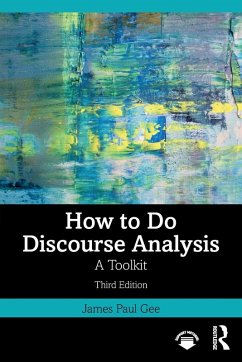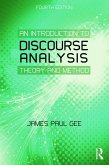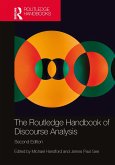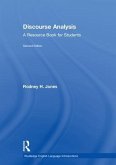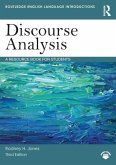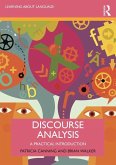- Broschiertes Buch
- Merkliste
- Auf die Merkliste
- Bewerten Bewerten
- Teilen
- Produkt teilen
- Produkterinnerung
- Produkterinnerung
How to do Discourse Analysis provides a comprehensive toolkit for conducting discourse analysis. This new edition incorporates recent developments in digital communication and updates examples for contemporary relevance, making it an ideal resource for advanced undergraduate and postgraduate students.
Andere Kunden interessierten sich auch für
![How to Do Discourse Analysis How to Do Discourse Analysis]() James Paul GeeHow to Do Discourse Analysis62,99 €
James Paul GeeHow to Do Discourse Analysis62,99 €![An Introduction to Discourse Analysis An Introduction to Discourse Analysis]() James Paul GeeAn Introduction to Discourse Analysis58,99 €
James Paul GeeAn Introduction to Discourse Analysis58,99 €![An Introduction to Discourse Analysis An Introduction to Discourse Analysis]() James Paul Gee (USA Arizona State University)An Introduction to Discourse Analysis54,99 €
James Paul Gee (USA Arizona State University)An Introduction to Discourse Analysis54,99 €![The Routledge Handbook of Discourse Analysis The Routledge Handbook of Discourse Analysis]() The Routledge Handbook of Discourse Analysis250,99 €
The Routledge Handbook of Discourse Analysis250,99 €![Discourse Analysis Discourse Analysis]() Rodney H. JonesDiscourse Analysis142,99 €
Rodney H. JonesDiscourse Analysis142,99 €![Discourse Analysis Discourse Analysis]() Rodney H. JonesDiscourse Analysis36,99 €
Rodney H. JonesDiscourse Analysis36,99 €![Discourse Analysis Discourse Analysis]() Patricia CanningDiscourse Analysis41,99 €
Patricia CanningDiscourse Analysis41,99 €-
-
-
How to do Discourse Analysis provides a comprehensive toolkit for conducting discourse analysis. This new edition incorporates recent developments in digital communication and updates examples for contemporary relevance, making it an ideal resource for advanced undergraduate and postgraduate students.
Produktdetails
- Produktdetails
- Verlag: Taylor & Francis Ltd
- 3 ed
- Seitenzahl: 236
- Erscheinungstermin: 28. Februar 2025
- Englisch
- Abmessung: 238mm x 153mm x 17mm
- Gewicht: 370g
- ISBN-13: 9781032884783
- ISBN-10: 1032884789
- Artikelnr.: 71301080
- Herstellerkennzeichnung
- Libri GmbH
- Europaallee 1
- 36244 Bad Hersfeld
- gpsr@libri.de
- Verlag: Taylor & Francis Ltd
- 3 ed
- Seitenzahl: 236
- Erscheinungstermin: 28. Februar 2025
- Englisch
- Abmessung: 238mm x 153mm x 17mm
- Gewicht: 370g
- ISBN-13: 9781032884783
- ISBN-10: 1032884789
- Artikelnr.: 71301080
- Herstellerkennzeichnung
- Libri GmbH
- Europaallee 1
- 36244 Bad Hersfeld
- gpsr@libri.de
James Paul Gee is a Regents Professor, Emeritus, at Arizona State University and an elected member of the National Academy of Education. He is the author of many books and papers on linguistics, literacy, discourse analysis, and learning. His books include What Video Games Have to Teach Us About Literacy and Learning (2007), Introducing Discourse: From Grammar to Society (2017), and What Is a Human? (2020).
Introduction
Unit 1: Language and Context
1.1 Grammar
1.2 Language Acquisition
1.3 Speed and Clarity
1.4 Context and Cultural Knowledge
1.5 Making the Taken-for-Granted New and Strange
1.6 Working with The Making Strange Tool
1.7 Deixis
1.8 Working with the Deixis Tool
1.9 Context
1.10 Working with the Fill-In Tool
1.11 Subjects and Predicates
1.12 Working with Subject Tool
1.13 Intonation
1.14 Working with the Intonation Tool
1.15 The Frame Problem
1.16 The Frame Problem in Action
1.17 Working with the Frame Tool
Unit 2: Saying, Doing, and Designing
2.1 People Do things with Language, Not Just Say Things
2.2 Working with Doing and Not Just Saying Tool
2.3 Grammar as Tools for Structure and Meaning
2.4 Working with the Grammar as Choice Tool
2.5 Vocabulary
2.6 Working with the Vocabulary Tool
2.7 Topics and Themes
2.8 Working with the Topic and Theme Tool
2.9 Stanzas
2.10 Working with the Stanza Tool
Unit 3: Building Things in the World
3.1 Building Tasks
3.2 Building Things with Language
3.3 An Example: A Collaboration around Oral History
3.4 The Context is Reflexive Tool
3.5 Working with the Context is Reflexive Tool
3.6 Working with the Significance Building Tool
3.7 Working with the Practices/Activities Building Tool
3.8 Working with the Identities Building Tool
3.9 Working with the Relationships Building Tool
3.10 Working with the Politics Building Tool
3.11 Working with the Connections Building Tool
3.12 Working with the Sign Systems and Knowledge Building Tool
3.13 Topic Flow or Topic Chaining Tool
3.14 Working with the Topic Flow or Topic Chaining Tool
Unit 4: Theoretical Tools
4.1 Six Theoretical Tools
4.2 The Situational Meaning Tool
4.3 Working with the Situational Meaning Tool
4.4 The Social Languages Tool
4.5 Working with the Social Languages Tool
4.6 The Intertextuality Tool
4.7 Working with the Intertextuality Tool
4.8 The Figured Worlds Tool
4.9 Working with the Figured Worlds Tool
4.10 The Big "D" Discourse Tool
4.11 Working with the Big "D" Discourse Tool
4.12 Notes about Discourses
4.13 Notes about DiscoursesThe Big "C" Conversation Tool
4.14 Working with the Big "C" Conversation Tool
4.15 Conclusion
Unit 1: Language and Context
1.1 Grammar
1.2 Language Acquisition
1.3 Speed and Clarity
1.4 Context and Cultural Knowledge
1.5 Making the Taken-for-Granted New and Strange
1.6 Working with The Making Strange Tool
1.7 Deixis
1.8 Working with the Deixis Tool
1.9 Context
1.10 Working with the Fill-In Tool
1.11 Subjects and Predicates
1.12 Working with Subject Tool
1.13 Intonation
1.14 Working with the Intonation Tool
1.15 The Frame Problem
1.16 The Frame Problem in Action
1.17 Working with the Frame Tool
Unit 2: Saying, Doing, and Designing
2.1 People Do things with Language, Not Just Say Things
2.2 Working with Doing and Not Just Saying Tool
2.3 Grammar as Tools for Structure and Meaning
2.4 Working with the Grammar as Choice Tool
2.5 Vocabulary
2.6 Working with the Vocabulary Tool
2.7 Topics and Themes
2.8 Working with the Topic and Theme Tool
2.9 Stanzas
2.10 Working with the Stanza Tool
Unit 3: Building Things in the World
3.1 Building Tasks
3.2 Building Things with Language
3.3 An Example: A Collaboration around Oral History
3.4 The Context is Reflexive Tool
3.5 Working with the Context is Reflexive Tool
3.6 Working with the Significance Building Tool
3.7 Working with the Practices/Activities Building Tool
3.8 Working with the Identities Building Tool
3.9 Working with the Relationships Building Tool
3.10 Working with the Politics Building Tool
3.11 Working with the Connections Building Tool
3.12 Working with the Sign Systems and Knowledge Building Tool
3.13 Topic Flow or Topic Chaining Tool
3.14 Working with the Topic Flow or Topic Chaining Tool
Unit 4: Theoretical Tools
4.1 Six Theoretical Tools
4.2 The Situational Meaning Tool
4.3 Working with the Situational Meaning Tool
4.4 The Social Languages Tool
4.5 Working with the Social Languages Tool
4.6 The Intertextuality Tool
4.7 Working with the Intertextuality Tool
4.8 The Figured Worlds Tool
4.9 Working with the Figured Worlds Tool
4.10 The Big "D" Discourse Tool
4.11 Working with the Big "D" Discourse Tool
4.12 Notes about Discourses
4.13 Notes about DiscoursesThe Big "C" Conversation Tool
4.14 Working with the Big "C" Conversation Tool
4.15 Conclusion
Introduction
Unit 1: Language and Context
1.1 Grammar
1.2 Language Acquisition
1.3 Speed and Clarity
1.4 Context and Cultural Knowledge
1.5 Making the Taken-for-Granted New and Strange
1.6 Working with The Making Strange Tool
1.7 Deixis
1.8 Working with the Deixis Tool
1.9 Context
1.10 Working with the Fill-In Tool
1.11 Subjects and Predicates
1.12 Working with Subject Tool
1.13 Intonation
1.14 Working with the Intonation Tool
1.15 The Frame Problem
1.16 The Frame Problem in Action
1.17 Working with the Frame Tool
Unit 2: Saying, Doing, and Designing
2.1 People Do things with Language, Not Just Say Things
2.2 Working with Doing and Not Just Saying Tool
2.3 Grammar as Tools for Structure and Meaning
2.4 Working with the Grammar as Choice Tool
2.5 Vocabulary
2.6 Working with the Vocabulary Tool
2.7 Topics and Themes
2.8 Working with the Topic and Theme Tool
2.9 Stanzas
2.10 Working with the Stanza Tool
Unit 3: Building Things in the World
3.1 Building Tasks
3.2 Building Things with Language
3.3 An Example: A Collaboration around Oral History
3.4 The Context is Reflexive Tool
3.5 Working with the Context is Reflexive Tool
3.6 Working with the Significance Building Tool
3.7 Working with the Practices/Activities Building Tool
3.8 Working with the Identities Building Tool
3.9 Working with the Relationships Building Tool
3.10 Working with the Politics Building Tool
3.11 Working with the Connections Building Tool
3.12 Working with the Sign Systems and Knowledge Building Tool
3.13 Topic Flow or Topic Chaining Tool
3.14 Working with the Topic Flow or Topic Chaining Tool
Unit 4: Theoretical Tools
4.1 Six Theoretical Tools
4.2 The Situational Meaning Tool
4.3 Working with the Situational Meaning Tool
4.4 The Social Languages Tool
4.5 Working with the Social Languages Tool
4.6 The Intertextuality Tool
4.7 Working with the Intertextuality Tool
4.8 The Figured Worlds Tool
4.9 Working with the Figured Worlds Tool
4.10 The Big "D" Discourse Tool
4.11 Working with the Big "D" Discourse Tool
4.12 Notes about Discourses
4.13 Notes about DiscoursesThe Big "C" Conversation Tool
4.14 Working with the Big "C" Conversation Tool
4.15 Conclusion
Unit 1: Language and Context
1.1 Grammar
1.2 Language Acquisition
1.3 Speed and Clarity
1.4 Context and Cultural Knowledge
1.5 Making the Taken-for-Granted New and Strange
1.6 Working with The Making Strange Tool
1.7 Deixis
1.8 Working with the Deixis Tool
1.9 Context
1.10 Working with the Fill-In Tool
1.11 Subjects and Predicates
1.12 Working with Subject Tool
1.13 Intonation
1.14 Working with the Intonation Tool
1.15 The Frame Problem
1.16 The Frame Problem in Action
1.17 Working with the Frame Tool
Unit 2: Saying, Doing, and Designing
2.1 People Do things with Language, Not Just Say Things
2.2 Working with Doing and Not Just Saying Tool
2.3 Grammar as Tools for Structure and Meaning
2.4 Working with the Grammar as Choice Tool
2.5 Vocabulary
2.6 Working with the Vocabulary Tool
2.7 Topics and Themes
2.8 Working with the Topic and Theme Tool
2.9 Stanzas
2.10 Working with the Stanza Tool
Unit 3: Building Things in the World
3.1 Building Tasks
3.2 Building Things with Language
3.3 An Example: A Collaboration around Oral History
3.4 The Context is Reflexive Tool
3.5 Working with the Context is Reflexive Tool
3.6 Working with the Significance Building Tool
3.7 Working with the Practices/Activities Building Tool
3.8 Working with the Identities Building Tool
3.9 Working with the Relationships Building Tool
3.10 Working with the Politics Building Tool
3.11 Working with the Connections Building Tool
3.12 Working with the Sign Systems and Knowledge Building Tool
3.13 Topic Flow or Topic Chaining Tool
3.14 Working with the Topic Flow or Topic Chaining Tool
Unit 4: Theoretical Tools
4.1 Six Theoretical Tools
4.2 The Situational Meaning Tool
4.3 Working with the Situational Meaning Tool
4.4 The Social Languages Tool
4.5 Working with the Social Languages Tool
4.6 The Intertextuality Tool
4.7 Working with the Intertextuality Tool
4.8 The Figured Worlds Tool
4.9 Working with the Figured Worlds Tool
4.10 The Big "D" Discourse Tool
4.11 Working with the Big "D" Discourse Tool
4.12 Notes about Discourses
4.13 Notes about DiscoursesThe Big "C" Conversation Tool
4.14 Working with the Big "C" Conversation Tool
4.15 Conclusion

